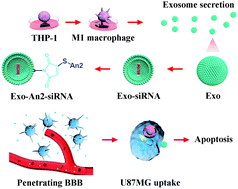Delivery of siRNA based on engineered exosomes for glioblastoma therapy by targeting STAT3†
Abstract
Small interfering RNA (siRNA) therapy has been considered as a promising strategy for treatment of glioblastoma (GBM), which is an aggressive brain disease with poor prognosis. However, siRNA therapy for GBM is seriously hindered by a multitude of barriers including possible immunogenicity, poor cellular uptake, short blood circulation, poor blood stability and low blood–brain barrier (BBB) penetration. This paper reports Angiopep-2 (An2)-functionalized signal transducers and activators of transcription 3 (STAT3) siRNA-loaded exosomes (Exo-An2-siRNA) as potential therapeutic agents to improve GBM therapy. The experimental results indicate that Exo-An2-siRNA displays high blood stability, efficient cellular uptake, and outstanding BBB penetration ability. Exo-An2-siRNA also exhibits excellent in vitro anti-GBM therapeutic effects due to the exosomes for siRNA protection and An2 modification for GBM targeting and BBB penetration. Such superior properties of Exo-An2-siRNA are responsible for favorable inhibition of the proliferation of orthotopic U87MG xenografts with limited side effects, significantly enhancing the median survival time (MST) of U87MG-bearing nude mice. The developed siRNA therapy featuring An2-functionalized exosomes as nanoplatforms is a safe and effective GBM treatment strategy.



 Please wait while we load your content...
Please wait while we load your content...